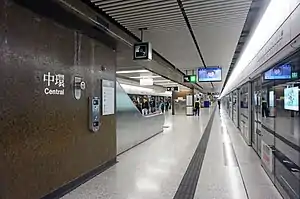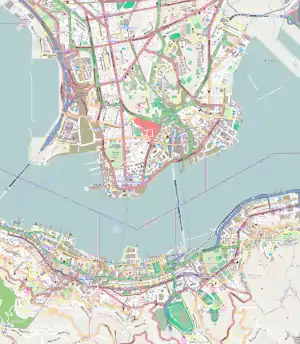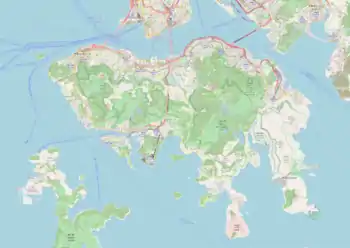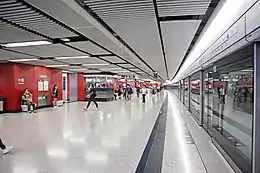Central station (MTR)
Central (Chinese: 中環; Cantonese Yale: Jūngwàan) is an MTR station located in the Central area of Hong Kong Island. The station's livery is firebrick red but brown on the Tsuen Wan line platforms. The station is the southern terminus of the Tsuen Wan line, a stop on the Island line, and connects to Hong Kong station, which serves the Tung Chung line and the Airport Express.
Central 中環 | ||||||||||||||||||||||||||||||||||||||||||||||||||||||||||||||||||||||||||||||||||||
|---|---|---|---|---|---|---|---|---|---|---|---|---|---|---|---|---|---|---|---|---|---|---|---|---|---|---|---|---|---|---|---|---|---|---|---|---|---|---|---|---|---|---|---|---|---|---|---|---|---|---|---|---|---|---|---|---|---|---|---|---|---|---|---|---|---|---|---|---|---|---|---|---|---|---|---|---|---|---|---|---|---|---|---|---|
 Platforms 1 and 2 on the Tsuen Wan line in January 2018 | ||||||||||||||||||||||||||||||||||||||||||||||||||||||||||||||||||||||||||||||||||||
| Chinese name | ||||||||||||||||||||||||||||||||||||||||||||||||||||||||||||||||||||||||||||||||||||
| Traditional Chinese | 中環 | |||||||||||||||||||||||||||||||||||||||||||||||||||||||||||||||||||||||||||||||||||
| Simplified Chinese | 中环 | |||||||||||||||||||||||||||||||||||||||||||||||||||||||||||||||||||||||||||||||||||
| Hanyu Pinyin | Zhōnghuán | |||||||||||||||||||||||||||||||||||||||||||||||||||||||||||||||||||||||||||||||||||
| Cantonese Yale | Jūngwàan | |||||||||||||||||||||||||||||||||||||||||||||||||||||||||||||||||||||||||||||||||||
| Literal meaning | Central ring | |||||||||||||||||||||||||||||||||||||||||||||||||||||||||||||||||||||||||||||||||||
| ||||||||||||||||||||||||||||||||||||||||||||||||||||||||||||||||||||||||||||||||||||
| General information | ||||||||||||||||||||||||||||||||||||||||||||||||||||||||||||||||||||||||||||||||||||
| Location | Des Voeux Road Central/Chater Road, Central Central and Western District, Hong Kong | |||||||||||||||||||||||||||||||||||||||||||||||||||||||||||||||||||||||||||||||||||
| Coordinates | 22°16′55″N 114°09′27″E | |||||||||||||||||||||||||||||||||||||||||||||||||||||||||||||||||||||||||||||||||||
| Owned by | MTR Corporation | |||||||||||||||||||||||||||||||||||||||||||||||||||||||||||||||||||||||||||||||||||
| Operated by | MTR Corporation | |||||||||||||||||||||||||||||||||||||||||||||||||||||||||||||||||||||||||||||||||||
| Line(s) | ||||||||||||||||||||||||||||||||||||||||||||||||||||||||||||||||||||||||||||||||||||
| Platforms | ||||||||||||||||||||||||||||||||||||||||||||||||||||||||||||||||||||||||||||||||||||
| Tracks | 4 | |||||||||||||||||||||||||||||||||||||||||||||||||||||||||||||||||||||||||||||||||||
| Connections | ||||||||||||||||||||||||||||||||||||||||||||||||||||||||||||||||||||||||||||||||||||
| Construction | ||||||||||||||||||||||||||||||||||||||||||||||||||||||||||||||||||||||||||||||||||||
| Structure type | Underground | |||||||||||||||||||||||||||||||||||||||||||||||||||||||||||||||||||||||||||||||||||
| Platform levels | 3 | |||||||||||||||||||||||||||||||||||||||||||||||||||||||||||||||||||||||||||||||||||
| Accessible | Yes | |||||||||||||||||||||||||||||||||||||||||||||||||||||||||||||||||||||||||||||||||||
| Other information | ||||||||||||||||||||||||||||||||||||||||||||||||||||||||||||||||||||||||||||||||||||
| Station code | CEN | |||||||||||||||||||||||||||||||||||||||||||||||||||||||||||||||||||||||||||||||||||
| History | ||||||||||||||||||||||||||||||||||||||||||||||||||||||||||||||||||||||||||||||||||||
| Opened |
| |||||||||||||||||||||||||||||||||||||||||||||||||||||||||||||||||||||||||||||||||||
| Previous names | Chater (Tsuen Wan line) Pedder (Island line) | |||||||||||||||||||||||||||||||||||||||||||||||||||||||||||||||||||||||||||||||||||
| Services | ||||||||||||||||||||||||||||||||||||||||||||||||||||||||||||||||||||||||||||||||||||
| ||||||||||||||||||||||||||||||||||||||||||||||||||||||||||||||||||||||||||||||||||||
| ||||||||||||||||||||||||||||||||||||||||||||||||||||||||||||||||||||||||||||||||||||
| Location | ||||||||||||||||||||||||||||||||||||||||||||||||||||||||||||||||||||||||||||||||||||
 Central Location within the MTR system  Central Central (Hong Kong urban core)  Central Central (Hong Kong Island) | ||||||||||||||||||||||||||||||||||||||||||||||||||||||||||||||||||||||||||||||||||||


The station was originally named Chater. It was initially conceived to cater for 330,000 passengers daily and was planned to be 380 m (1,250 ft) long – one of the longest stations in the world.[1] More than 200,000 passengers use this station daily. The longest distance between two exits is approximately 700m.
History
Early plans
Central station was included in the Hong Kong Mass Transport Study, a system proposed in September 1967.[2] Together with Western Market station, it was to serve as an interchange station of the Kwun Tong line and Island line. In the recommended system, the Tsuen Wan line would terminate at Admiralty. The station was originally planned to be located under Des Voeux Road Central between Jubilee Street and Pedder Street.
In 1970, in the Hong Kong Mass Transit Further Studies, the station was proposed as two separate but connected stations: Chater station (遮打站) under Chater Road and Pedder station (必打站) under Pedder Street), which would serve the Kong Kow line (now Tsuen Wan line) and Island line respectively.
Modified Initial System and opening
The station first opened as Chater station on 12 February 1980 as the terminus of the Kwun Tong line. Only a portion of the station came into operation as the Island line had not been opened yet.
The station was named Chater in English but 中環 (Central) in Chinese. This would be misleading as many thought that the Chinese name would be 遮打, a transliteration and the Chinese name of the namesake road. When the Island line between Admiralty and Chai Wan opened on 31 May 1985, MTR renamed Chater to Central together with the renaming of some other stations on the Kwun Tong and Tsuen Wan lines.
Construction for the Island line was carried out in early 1983 and connected the new platforms with the original structure. The Island line began servicing Central on 23 May 1986 when it was extended beyond Admiralty to Sheung Wan and the Island line platforms came into service.
Passageway to Hong Kong station
One component of the Airport Core Programme[3] between 1991 and 1998 was a railway connecting the new Hong Kong International Airport to the city centre. To link Central with the nearby Hong Kong station, the southern terminus of the Tung Chung line and the Airport Express, a passageway was built under Connaught Road to connect the two stations. The passageway starts at the Pedder Street concourse and was built with a design similar to that of Hong Kong station. The passage connects the paid areas of both stations (particularly from Central to the Tung Chung line of Hong Kong station). There is no unpaid link (though access to the Airport Express line at Hong Kong station from other lines at Central or vice versa requires an out-of-system transfer as the Airport Express line follows a separate fare scheme from the rest of the MTR system).

Station layout
Central station has four platforms on three levels.
The top level includes platform 3 and is built beneath Des Voeux Road Central at the intersection of Pedder Street, stretching from World-Wide House to Alexandra House, on the northern side of the road. The platform serves Chai Wan-bound trains on the Island line and this level includes the connecting walkway to Hong Kong station.
The middle level includes platforms 1 and 2 using a shared island. They serve the Tsuen Wan line and were built directly under Chater Road, extending from Des Voeux Road Central to Club Street.
The bottom level, two levels from the top level, is platform 4, for Island line trains in the direction of Kennedy Town.
Passengers from platform 3 transferring to platforms 1 or 2 use the regular escalators on the Chater Road concourse. There are designated escalators from platforms 1 and 2 to platform 4 for the sole purpose of transfer.[4]
The Tsuen Wan line platforms are straight and were built by cut-and-cover. Most of the length of the Island line platforms is the same, although the eastern part (towards Admiralty) is curved and the gap is large, as they are located in sections of bored tunnels and have the curved walls typical of most other stations on the Island line.
| G | Street level | Exits |
| P | Chater Road concourse | – |
| L1 | Pedder Street concourse | Customer Service, MTRShops Hang Seng Bank, vending machines Octopus promotion machine |
| Chater Road concourse | Customer Service, MTRShops ATM | |
| L2 | Chater Road concourse | Customer Service, MTRShops Hang Seng Bank, vending machines |
| Pedder Street concourse | Customer Service, MTRShops Subway to Hong Kong station for Tung Chung line & Airport Express Octopus promotion machine, i-centre internet service | |
| Side platform, doors will open on the left | ||
| Platform 3 | Island line towards Chai Wan (Admiralty) → | |
| L3 | Platform 1 | Tsuen Wan line towards Tsuen Wan (Admiralty) → |
| Island platform, doors will open on the left or right | ||
| Platform 2 | Tsuen Wan line towards Tsuen Wan (Admiralty) → | |
| L4 | Side platform, doors will open on the right | |
| Platform 4 | ← Island line towards Kennedy Town (Sheung Wan) | |
Entrances and exits
Central station stretches underneath Chater Road from Statue Square in the east and underneath Des Voeux Road to Li Yuen Street East in the west. The distance between the easternmost and westernmost exits is approximately 700m. There are 13 entrances, connecting buildings, shopping malls, main roads and ground transport facilities nearby.[5]
- Pedder Street Concourse
- A
 : Connaught Road Central, Central Pier
: Connaught Road Central, Central Pier - B: World-wide House, Hang Seng Bank Headquarters
- C: Li Yuen Street (East & West)
- D1: Pedder Street
- D2: Queens Road Central, Lan Kwai Fong
- Chater Road Concourse
- E: Chater House
- F: St George's Building, Mandarin Oriental Hotel
- G: The Landmark
- H: Alexandra House
- J1: Court of Final Appeal
- J2: Chater Garden, Bank of China Tower, Peak Tram station, Cheung Kong Center
- J3: AIA Central, Bank of America Tower
- K: Statue Square, HSBC Main Building, Standard Chartered Bank Building
- L
 : CCB Tower
: CCB Tower
Transport connections
Central station is one of the transport hubs of Hong Kong. The area around Central station and Hong Kong station offers a wide range of transport options, including the tramway, buses, ferries, minibuses and more. (See also Transport in Hong Kong)
- Bus
- Citybus
- KMB, serving only cross-harbour routes on Hong Kong Island
- New World First Bus
- Nearby bus termini:
- Central Piers Bus Terminus (exit A or E then via footbridge, of within paid area via Hong Kong station)
- City Hall Bus Terminus (exit K then via tunnel)
- Exchange Square Bus Terminus (exit A then via footbridge, or within paid area via Hong Kong station)
- Minibus
- Trams
- Hong Kong Tramways (exits B, C, G and K)
- Peak Tram (exit J2)
- Ferries (exit A to Central Ferry Piers)
- Pier 2: Park Island Ferry, to Park Island
- Pier 3: Discovery Bay Ferry, to Discovery Bay
- Pier 4: Hong Kong & Kowloon Ferry, to Sok Kwu Wan and Yung Shue Wan on Lamma Island
- Piers 5 and 6: Sun Ferry, to Silvermine Bay (Mui Wo), Peng Chau and Cheung Chau
- Pier 7: Star Ferry, to Tsim Sha Tsui
References
- "MTR briefing for public". Hong Kong: South China Morning Post. 3 December 1976.
- Freeman, Fox (1967). Hong Kong Mass Transport Study. Wilbur Smith & Associates.
- "(map)". Hong Kong Airport Core Programme. Archived from the original on 5 April 2005.
- "Central Station layout" (PDF). MTR Corporation. Retrieved 30 July 2014.
- "Central Station street map" (PDF). MTR Corporation. Retrieved 30 July 2014.